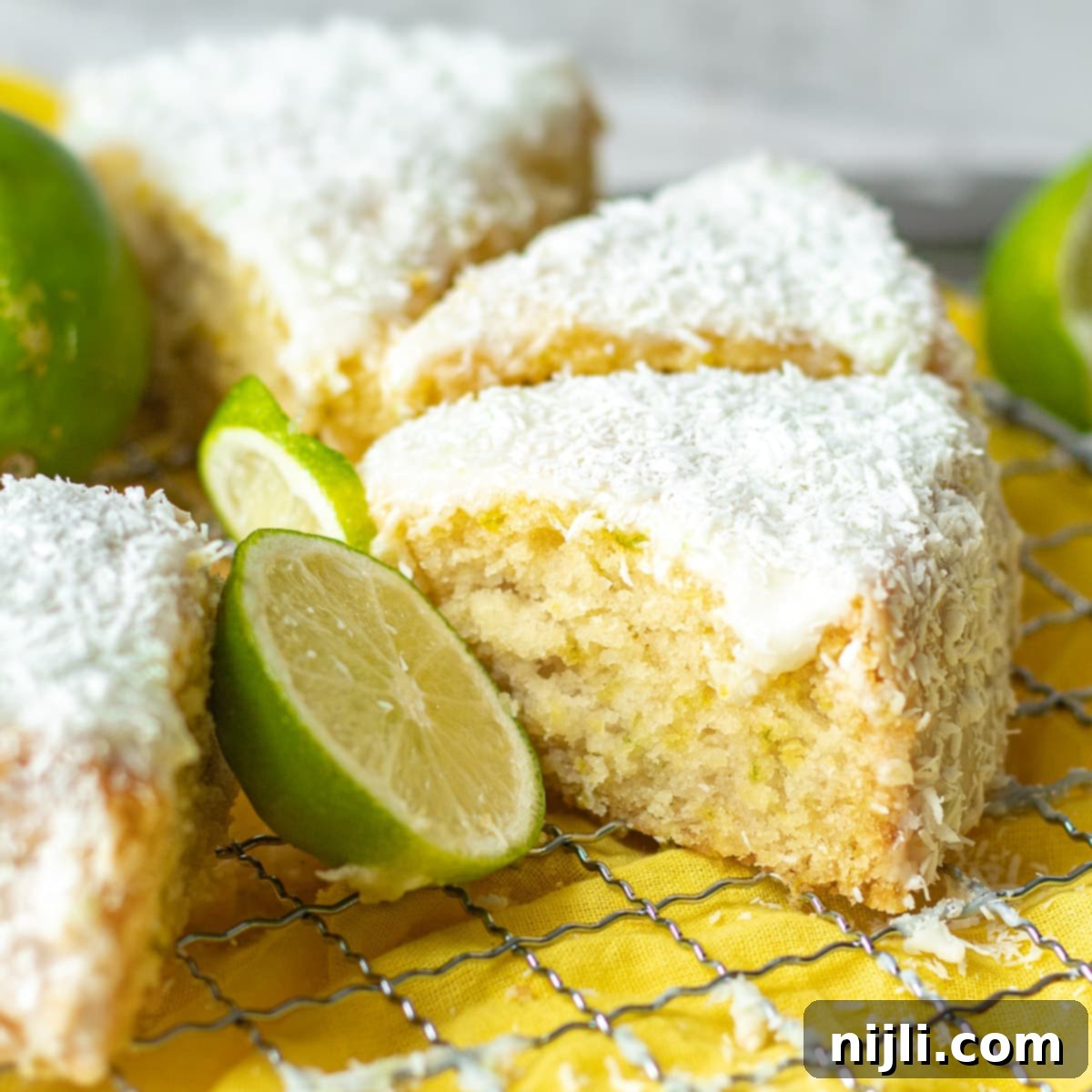Irresistible Vegan Coconut Cake with Zesty Lime Glaze: Your Go-To Dairy-Free & Egg-Free Celebration Dessert
Prepare to be enchanted by the best vegan coconut cake you’ll ever taste! This extraordinary recipe features a wonderfully moist, tender cake base crowned with a vibrant and rich lime glaze. Entirely free from eggs and dairy, this plant-based coconut cake isn’t just a dessert; it’s an effortless celebration showstopper that will delight both vegans and non-vegans alike. Get ready to bake a truly delicious and surprisingly simple treat that promises to become a firm favorite.
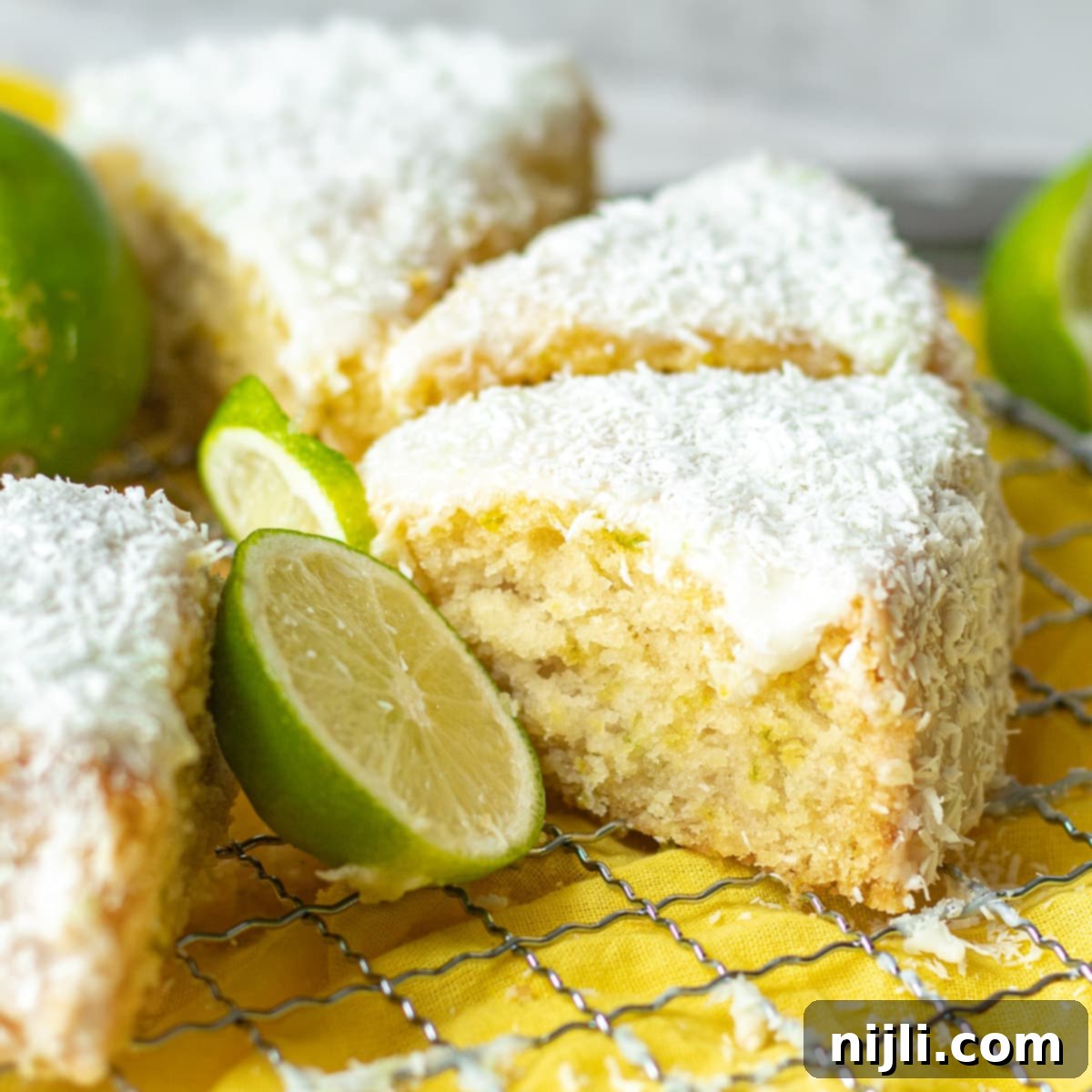
*This post contains affiliate links — as an Amazon Associate I earn from qualifying purchases. Please see my disclosure for details*.
If the tantalizing thought of this vegan coconut and lime cake has captured your imagination, you’ll undoubtedly adore my other plant-based delights! Be sure to try my Vegan Olive Oil Cake with Lemon and Pistachio for a delicate, citrusy treat, my Vegan Pineapple Upside Down Cake for a tropical twist, or my Almond Flour Peanut Butter Cookies for a quick and satisfying snack!
[feast_advanced_jump_to]
Crafting the Perfect Vegan Coconut and Lime Cake
This egg and dairy-free coconut cake recipe truly stands out as a culinary triumph. From the very first bite, you’ll be amazed by its incredibly moist, rich, and utterly decadent texture. It’s designed to impress, ensuring that both your vegan friends and those who typically enjoy traditional desserts will be eager for a second slice. The exquisite pairing of sweet, tropical coconut with the bright, zesty notes of lime creates a flavor profile that is nothing short of perfection.
What makes this particular recipe even more appealing is its simplicity. Unlike multi-layered confections, this is a single-layer vegan coconut and lime cake, making it remarkably easy to prepare. The straightforward glazing process further streamlines the baking experience, allowing you to achieve stunning results without unnecessary fuss. Whether you’re a seasoned baker or just starting your plant-based culinary journey, this recipe provides a stress-free path to a truly delicious dessert.

Honoring Heritage: Black History Month Virtual Potluck 2022 & Afrofuturism
I was immensely proud to join forces with over 30 talented Black recipe developers in 2022 to celebrate Black History Month. This special Virtual Potluck event served as a culinary exploration of Black food through the captivating lens of Afrofuturism. Our collective of recipes aimed to highlight the intricate intersection of the Black diaspora, weaving together themes of culture, future, geopolitics, imagination, liberation, and technology into a tapestry of flavors and stories.
I encourage you to explore, cook, and share the inspiring recipes from this collaborative project by reviewing the list of participants below. By following each participant and engaging with us on social media using the hashtag #BHMVP2022, you can continue the important discussion surrounding Black culinary heritage and its future.
Understanding Afrofuturism Through Food
Afrofuturism is a fluid ideology shaped by generations of artists, musicians, scholars, and activists whose aim is to reconstruct “Blackness” in the culture … The term was coined by Mark Dery in 1993 but birthed in the minds of enslaved Africans who prayed for their lives and the lives of their descendants along the horrific Middle Passage … Afrofuturism evaluates the past and future to create better conditions for the present generation of Black people through the use of technology, often presented through art, music, and literature.
Taylor Crumpton, “Afrofuturism Has Always Looked Forward,”Architectural Digest, August 24, 2020
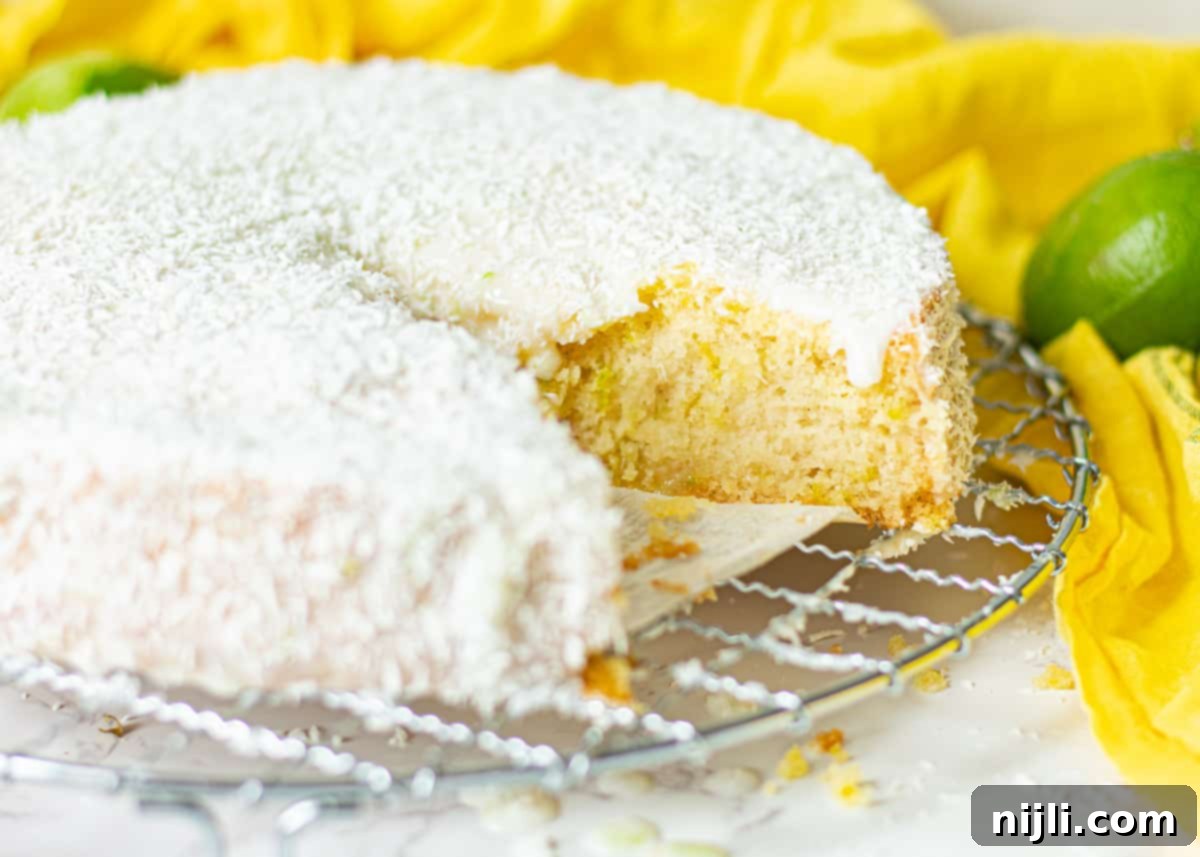
How This Vegan Coconut and Lime Cake Embodies Afrofuturism
This particular vegan coconut and lime cake recipe offers a delicious intersection of past, present, and future, making it a perfect culinary representation of Afrofuturism:
Past and Present: Coconut cake holds a deeply significant place within the soul food tradition of Black communities in the United States. Historically, it’s often recognized as a buttery, layered dessert adorned with rich cream cheese frosting. Its roots trace back to enslaved Africans who brought invaluable agricultural and culinary knowledge, including how to work with coconuts, to the Americas. Over generations, this dessert has transformed into a cherished symbol of celebration and comfort for Black Americans.
Future: With this modern adaptation, my goal is to honor and evoke the beloved traditions of soul food desserts, such as coconut cake, while simultaneously envisioning a future that embraces more plant-based and health-conscious dietary choices. While soul food is frequently associated with rich, comforting dishes abundant in meat and dairy, it’s vital to remember that traditional foods across the African diaspora are rich in colorful, whole-food ingredients that align seamlessly with a plant-based diet. This forward-thinking approach is already evident: Black Americans are currently the fastest-growing vegan demographic in the United States, driven by considerations for health, ethical concerns, and environmental sustainability. Therefore, this vegan coconut cake serves as a culinary bridge, connecting a cherished soul food tradition with the evolving direction of Black cuisine and our mindful culinary future.
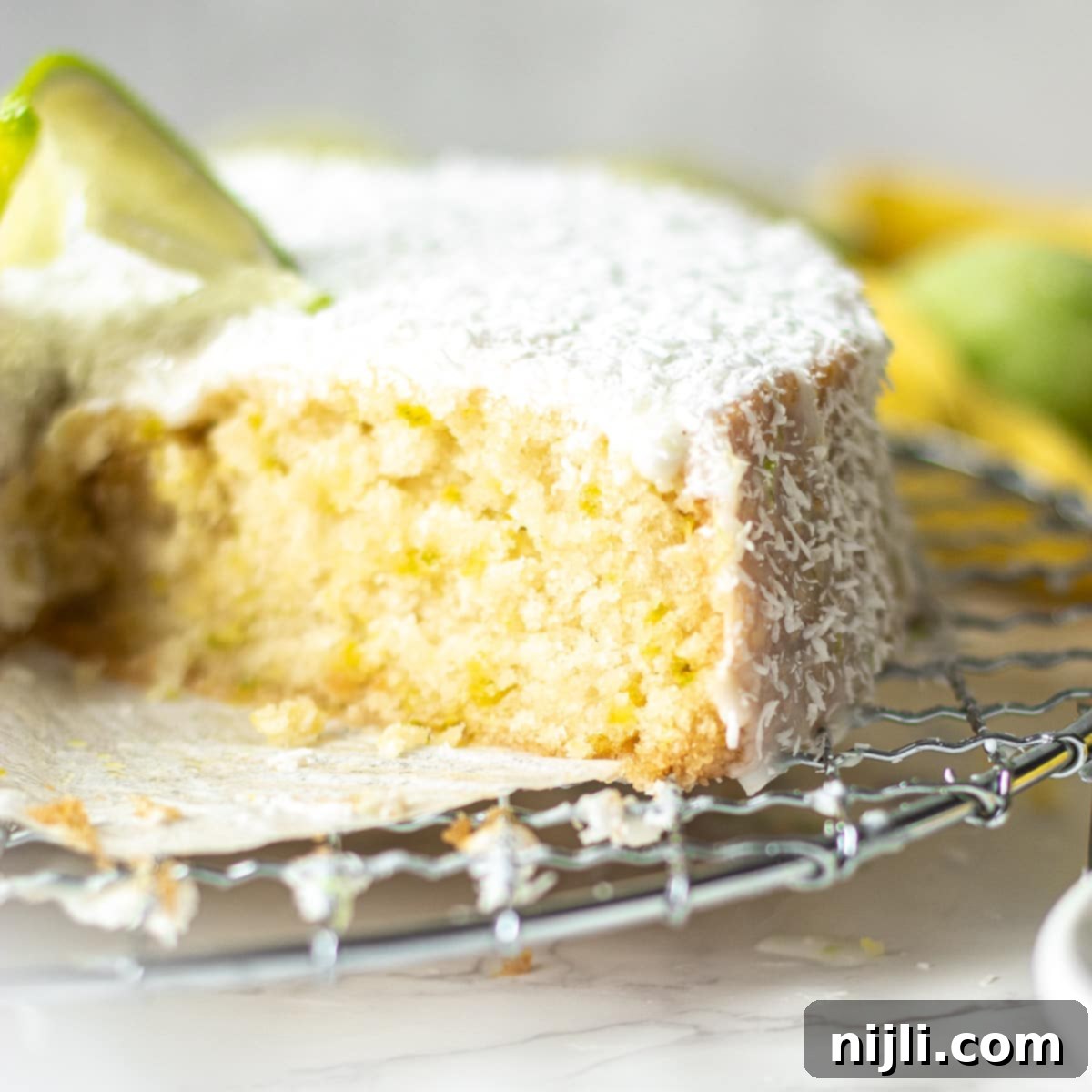
The Enduring Legacy and Meaning of Coconut Cake
The story of coconut cake is deeply interwoven with American history and the enduring resilience of Black culture. Its origins can be traced back to enslaved Africans in the southern United States, who brought with them not only their rich cultural heritage but also invaluable knowledge of working with and utilizing coconuts. This expertise laid the foundation for coconut cake to become an integral part of plantation life for enslaved people, sometimes even serving as a coveted prize for the winner of a cakewalk—a social event that combined music, dancing, and competition. Over centuries, what began as a symbol of resourcefulness and ingenuity has evolved into a beloved celebration dessert for Black Americans, solidifying its place as a popular and cherished staple within the soul food tradition that continues to thrive today.
What Makes Vegan Coconut Cake Unique? The Plant-Based Difference
Our vegan coconut cake offers a delightful departure from a typical coconut cake, primarily because it is meticulously crafted without any animal products. This means a complete absence of eggs, dairy milk, or cream cheese, which are traditional components. To ensure a perfectly tender crumb and rich flavor, we thoughtfully incorporate plant-based alternatives. Instead of conventional granulated sugar, which can sometimes be processed using animal bone char, we opt for organic cane sugar, maintaining the recipe’s vegan integrity.
Furthermore, we introduce a vibrant and refreshing boost of fresh lime, an ingredient that not only complements the sweet coconut flavor beautifully but also holds cultural significance, being a common and beloved ingredient in many cuisines of the African diaspora. This thoughtful inclusion elevates the flavor profile, creating a truly unique and refreshing dessert experience while staying true to its cultural inspiration. The result is a cake that is not only delicious but also aligns with ethical, environmental, and health-conscious choices.
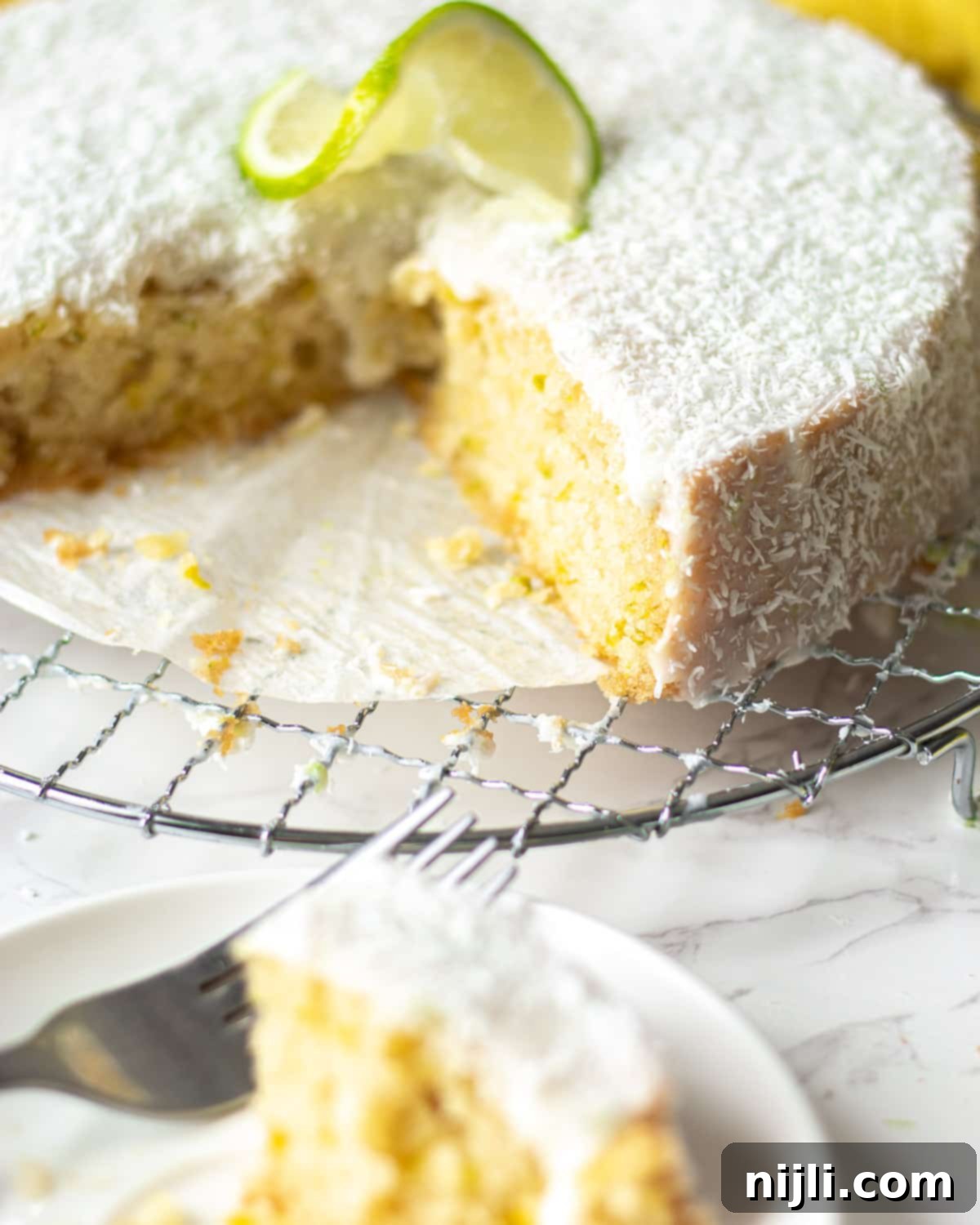
The Luscious Vegan Coconut Cake Topping: A Simple Lime Glaze
Instead of the traditional cream cheese frosting, often laden with sweetened shredded coconut, our coconut milk cake is finished with an incredibly simple yet profoundly rich coconut-lime glaze. This plant-based glaze is not only a breeze to prepare but also delivers a decadence that perfectly captures the essence of what a coconut cake topping should be. It provides a luscious, pourable coating that adds moisture and an extra layer of flavor without the heaviness of typical frosting.
To beautifully balance the sweetness of the glaze and add a delightful textural contrast, we generously sprinkle the cake with a layer of unsweetened shredded coconut. This thoughtful addition ensures that every bite offers a harmonious blend of creamy glaze, tender cake, and the satisfying chew of fresh coconut, making it an absolute treat for the senses.
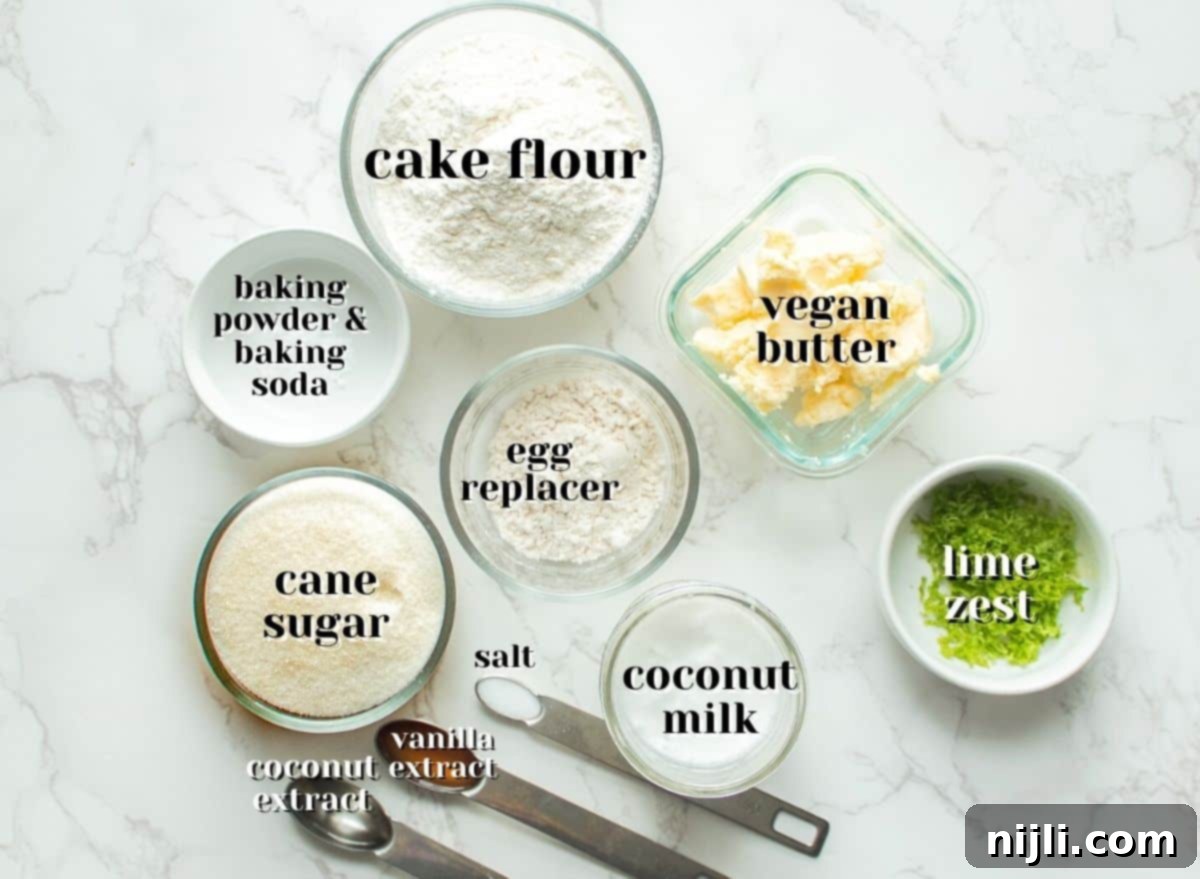
Key Ingredients for Your Delicious Vegan Coconut Cake
Creating this exquisite dairy-free coconut cake requires a selection of thoughtful plant-based ingredients, each playing a vital role in achieving its moist texture and vibrant flavor profile:
- Egg Replacer: For a flawlessly tender crumb and excellent lift, I highly recommend Bob’s Red Mill Egg Replacer. It consistently delivers the ideal texture for this cake. Alternatively, you can easily create a flax egg using flaxseed meal and water – detailed instructions are provided below in the FAQ section.
- Cake Flour: The secret to this coconut milk cake’s superior softness and delicate crumb lies in using cake flour instead of standard all-purpose flour. Its lower protein content results in a lighter, more tender texture. For those seeking a vegan gluten-free coconut cake, a 1-to-1 gluten-free flour blend can be substituted. Always measure your flour precisely, ideally by weight with a kitchen scale, or by using the careful spoon-and-level method to avoid a dense cake.
- Baking Powder and Baking Soda: These essential leavening agents are crucial for giving this cake its impressive rise and airy, fluffy texture. Ensure they are fresh for optimal results.
- Lime Zest: My absolute favorite ingredient in this recipe! The bright, aromatic zest of lime infuses this vegan coconut and lime cake with a unique and incredibly delicious citrusy tang that perfectly complements the coconut. Be sure to use fresh limes for the best flavor.
- Salt: A small but mighty ingredient, salt is vital for enhancing all the other flavors in the cake and subtly cutting through its sweetness, creating a more balanced taste.
- Vegan Butter: I achieved wonderful results using Earth Balance Organic Buttery Spread for this dairy-free coconut cake recipe. The key is to ensure your vegan butter is at room temperature before incorporating it, as this allows for proper creaming with the sugar, leading to a lighter cake texture.
- Organic Cane Sugar: To maintain the recipe’s vegan integrity, we specifically use organic cane sugar, as conventional granulated sugar can sometimes be processed with animal bone char. It provides the perfect sweetness for our cake.
- Coconut Extract: While optional, I strongly believe that adding coconut extract significantly amplifies the rich, tropical flavor in this coconut milk cake, making it even more intensely coconutty and delightful.
- Vanilla Extract: Always opt for a high-quality pure vanilla extract for the best flavor. For an extra touch of homemade goodness, consider checking out my post on how to make vanilla extract at home with just two simple ingredients!
- Canned Full-Fat Coconut Milk: This is the backbone of our moist coconut cake. Remember to shake the can well before measuring to ensure all the rich cream is incorporated. While full-fat is recommended for richness, you can also use coconut milk from a carton for a slightly lower fat content, though the texture might be a little less decadent.
- Fresh Lime Juice: Beyond just flavor, fresh lime juice adds a lovely tartness and works synergistically with the baking soda to contribute to the cake’s light and airy texture.
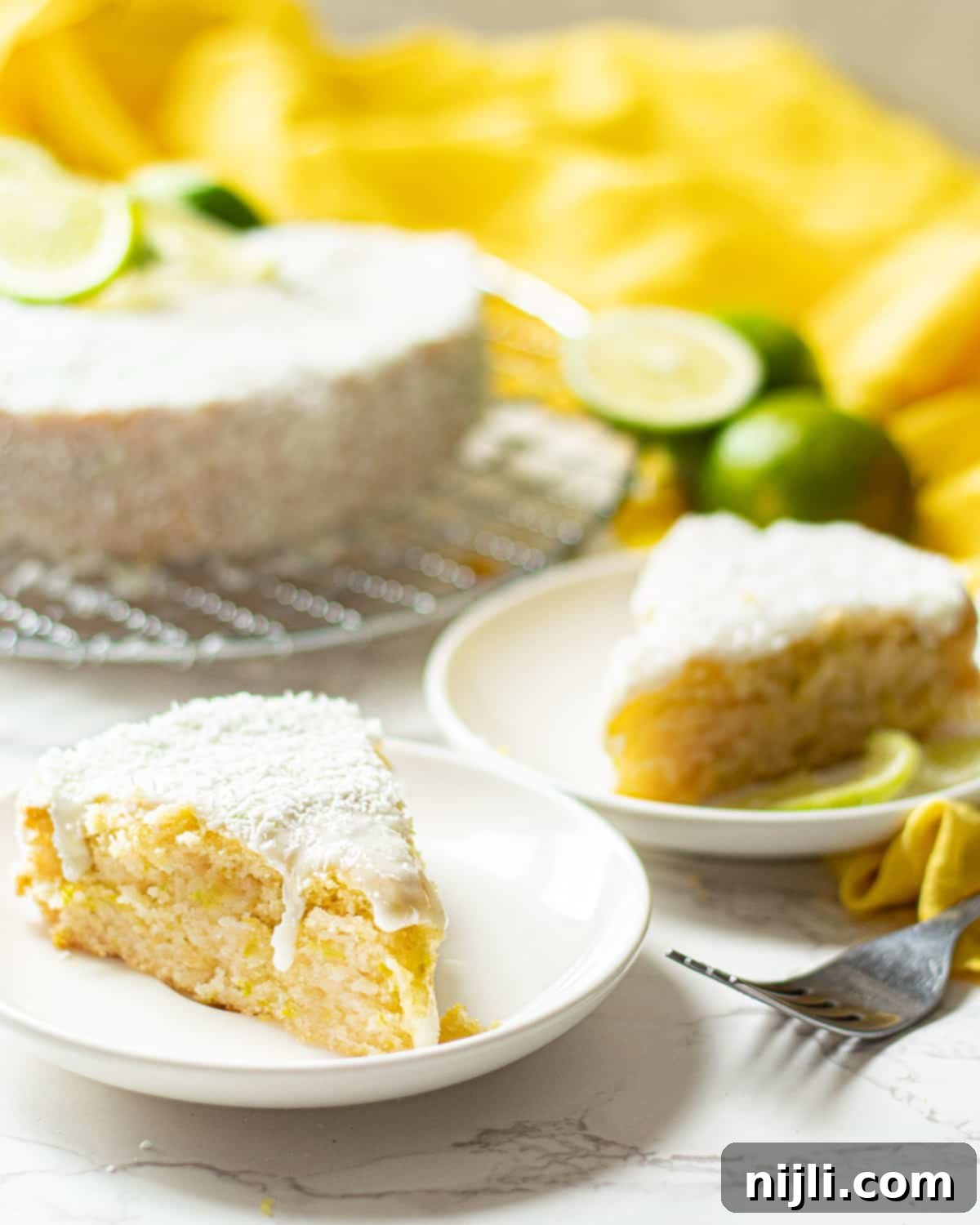
And to craft that perfect, creamy lime glaze, you’ll need these key components:
- Vegan-Friendly Powdered Sugar: Just like with the cake, ensure your powdered sugar is certified vegan. Accurate measurement is crucial for the glaze’s consistency, so either measure by weight or use the precise spoon-and-level method.
- Lime Zest: A touch more fresh lime zest in the glaze further intensifies that bright, refreshing lime flavor, creating a harmonious balance with the sweet coconut.
- Coconut Milk: Using coconut milk in the glaze not only ensures it’s dairy-free but also imparts a wonderful creaminess and reinforces the cake’s overall coconut essence. Adjust the amount as needed to achieve your desired pourable consistency.
- Unsweetened Shredded Coconut: While many traditional coconut cakes use sweetened shredded coconut for topping, I prefer unsweetened shredded coconut in my baking. This allows me to control the overall sweetness level of the dessert. On this cake, the unsweetened coconut provides a perfect counterpoint to the sweet glaze, offering a delightful texture and balanced flavor.
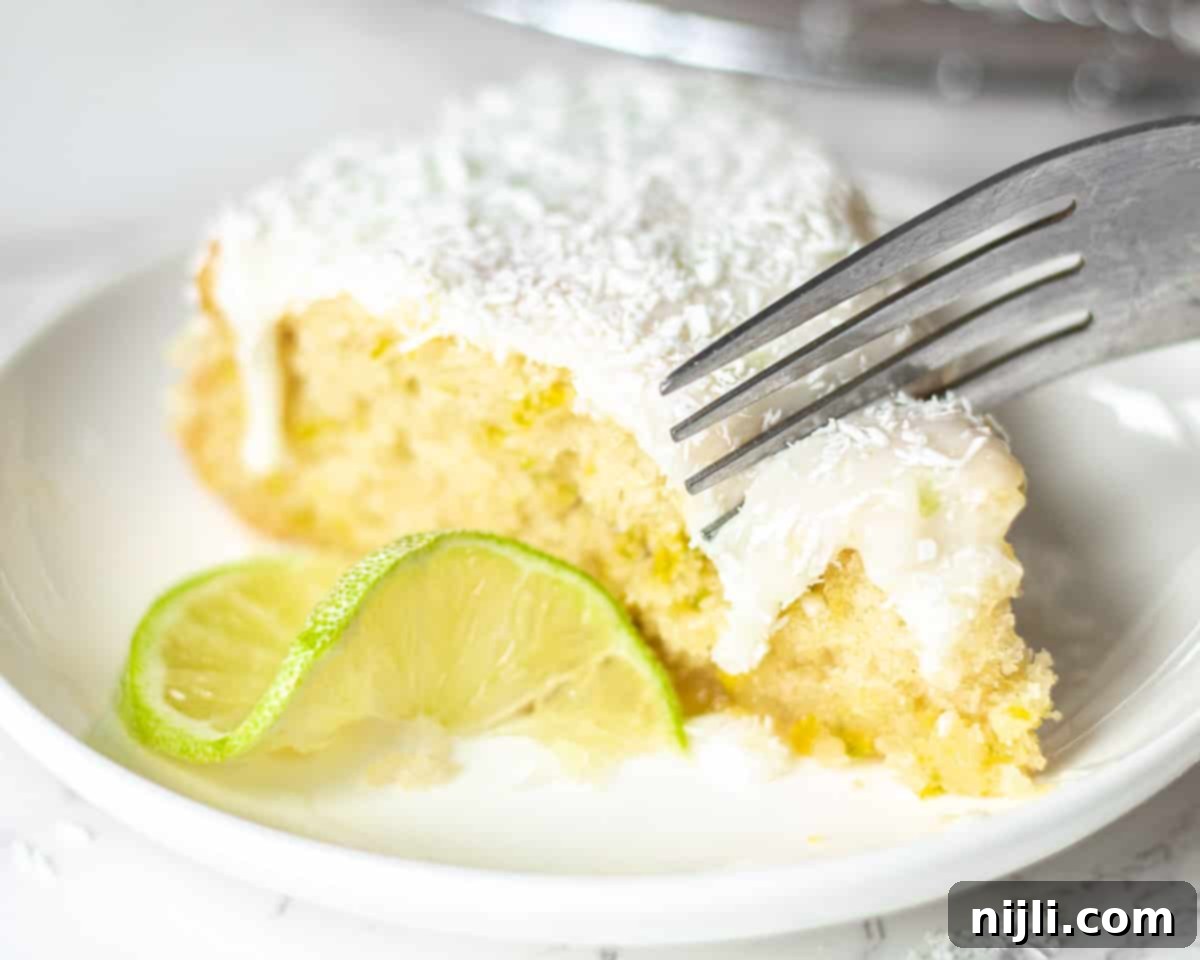
Essential Equipment for Your Dairy-Free Coconut Cake
One of the many reasons this dairy-free coconut cake is so wonderfully simple to make is that it doesn’t require a plethora of specialized tools. You’ll only need a few basic items to whip up your delicious cake batter. A reliable hand mixer (or a stand mixer for even greater ease) and a couple of mixing bowls will be sufficient for blending your ingredients to perfection. For baking, a single 8-inch round cake pan will do the trick, lined with parchment paper to ensure a clean release.
To ensure consistent and accurate results in all your baking endeavors, I always highly recommend using a kitchen scale to measure your dry ingredients by weight. This method drastically reduces common baking errors. Once your cake is out of the oven, a sturdy wire rack is essential for allowing your finished cake to cool completely, preventing any sogginess and ensuring the perfect texture.
Expert Tips and Frequently Asked Questions for Vegan Coconut Cake
Achieving that perfect, lifted, and fluffy texture in an egg and dairy-free coconut cake requires strategic ingredient choices. In this recipe, we cleverly substitute traditional eggs with Bob’s Red Mill Egg Replacer. This plant-based alternative excels at providing the binding and leavening properties typically found in eggs, resulting in a beautifully light cake. Simply follow the package directions to mix the Egg Replacer with water before incorporating it into your batter.
If you prefer to use flax eggs, you can easily make them by combining 2 tablespoons of flaxseed meal with 5 tablespoons of water. Allow this mixture to sit for about 5 minutes until it thickens into a gel-like consistency before adding it to your cake batter. A crucial tip for flax eggs: because they provide less lift than commercial egg replacers, I recommend adding an extra ¼ teaspoon each of both baking soda and baking powder to your dry ingredients. This will give your vegan coconut cake the additional boost it needs to achieve that desired light and airy texture.
For this exquisite vegan coconut and lime cake, the key to a beautiful and even coconut topping is timing and technique. After pouring the luscious coconut-lime glaze over the completely cooled cake, allow the glaze to set slightly, becoming tacky but not fully hardened. This typically takes about 10-15 minutes. Once it’s reached this ideal consistency, generously sprinkle a large handful of unsweetened shredded coconut over the entire top surface of the cake, ensuring full coverage.
Next, gently tilt the cake, holding it over a baking sheet or large plate to catch any excess coconut. With your free hand, sprinkle additional coconut onto the sides, gently pressing it into the glaze if necessary. Continue this process, adding extra handfuls of coconut to fill any gaps, until the top and sides are evenly coated. The result will be a stunningly textured cake with a delicious coconut topping that perfectly complements the sweet and zesty glaze.
If your vegan cake isn’t as fluffy as you’d hoped, several factors could be at play. First, always check the freshness of your leavening agents – baking powder and baking soda. These ingredients lose their potency over time; once opened, they are typically only active and fresh for about six months. Using expired leaveners will significantly hinder your cake’s rise.
Secondly, precise flour measurement is critical. Too much flour can lead to a dense, heavy cake. Always measure flour by weight using a kitchen scale, or meticulously use the spoon-and-level method, rather than scooping directly from the bag.
Another common pitfall is overmixing the batter. Once you combine the wet and dry ingredients, mix only until they are just incorporated. Overmixing can overdevelop the gluten in the flour, resulting in a tough and dense texture instead of a tender, fluffy one.
Finally, an inaccurate oven temperature can prevent proper rising. Ovens can sometimes run hotter or colder than their display indicates. It’s always a good idea to double-check your oven’s calibration with an oven thermometer to ensure it’s baking at the correct temperature for an optimal rise.
This delightful coconut milk cake can be stored at room temperature for one to two days. Simply place it in an airtight container to maintain its freshness and prevent it from drying out. If you wish to preserve it for a longer period, this cake freezes exceptionally well! To prepare for freezing, first, place the cake (uncovered) on a plate in the freezer for about 15 minutes. This step allows the lime glaze to harden slightly, preventing it from sticking to the wrapping. Once the glaze is firm, meticulously wrap the entire cake in several layers of plastic wrap, followed by a layer of heavy-duty aluminum foil or place it in a freezer-safe bag. It can be stored in the freezer for up to 2 months. To serve, thaw the cake, uncovered, at room temperature until it’s soft. If desired, you can sprinkle with a bit of extra shredded coconut before enjoying.
If you embark on making this incredible recipe, I would be absolutely thrilled if you could leave a star review rating and a comment below! Your feedback is incredibly valuable and it’s always so wonderful to hear about your culinary successes. And please, don’t forget to share your beautiful creations with me by tagging @chenee_today on Instagram!
More Delicious Vegan Recipes You’ll Love
- Vegan Couscous Salad with Charred Corn
- Air Fryer Sweet Potato Chunks
- Almond Lemon Cookies
- Vegan Peanut Butter Oatmeal Cookies with Banana and Cacao
- Strawberry Banana Sorbet
📖 Recipe

Vegan Coconut Cake with Lime Glaze
Pin Recipe
Rate Recipe
Save RecipeSaved!
Equipment you may need
-
measuring cups and spoons
-
hand mixer
-
mixing bowls
-
parchment paper
-
whisk
-
rubber spatula
-
food scale
-
cooling rack
-
stand mixer
-
cooling rack
-
8-inch round cake pans
Ingredients
- baking spray
- 2 tablespoon (14 g) egg replacer – or flaxseed meal – see notes below for instructions
- ¼ cup (59 g) water
- 1 ½ cup (188 g) cake flour – measured by weight or with spoon-and-level method for best results
- 1 ¼ teaspoons (5 g) baking powder
- ¼ teaspoon (1 ml) baking soda
- 1½ tablespoon (9 g) lime zest – packed (from about 2 medium limes, ensures bright flavor)
- ½ teaspoon (3 g) salt – to balance sweetness
- ½ cup (114 g) vegan butter – at room temperature for optimal creaming
- 1 cup (200 g) organic cane sugar – ensures vegan friendly status
- 1 teaspoon (5 ml) coconut extract – optional, but enhances coconut flavor significantly
- ¾ teaspoon (4 ml) pure vanilla extract – for a classic, comforting aroma
- ⅔ cup (151 g) canned full-fat coconut milk – shake the can vigorously before measuring for best consistency
- 1 tablespoon (15 ml) fresh lime juice – adds tang and works with leaveners for lift
For the Luscious Coconut-Lime Glaze
- 2 cups (240 g) vegan-friendly powdered sugar – ensure it’s bone char-free; measure by weight or spoon-and-level method
- 1 teaspoon (2 g) lime zest – packed, for an extra burst of citrus aroma
- ¼ cup (57 g) coconut milk – add more as needed, a teaspoon at a time, to achieve your desired pourable consistency
- shredded unsweetened coconut – for topping and texture, balancing the glaze’s sweetness
Instructions
-
Preheat your oven to 350°F (175°C). Line an 8-inch round cake pan with parchment paper and generously spray it with baking spray to prevent sticking.baking spray
-
In a small bowl or cup, prepare your egg replacer (or flax egg, see notes below for detailed instructions) by combining the specified amount of egg replacer powder with water. Whisk well until fully incorporated and set aside to thicken.2 tablespoon egg replacer, ¼ cup water
-
In a separate medium bowl, thoroughly whisk together the cake flour, baking powder, baking soda, vibrant lime zest, and salt. Ensure these dry ingredients are well combined before setting the bowl aside.1 ½ cup cake flour, 1 ¼ teaspoons baking powder, ¼ teaspoon baking soda, 1½ tablespoon lime zest, ½ teaspoon salt
-
In a large mixing bowl, or the bowl of your stand mixer fitted with the paddle attachment, cream together the room temperature vegan butter and organic cane sugar. Beat them together for about 2-3 minutes until the mixture is light, fluffy, and pale in color.½ cup vegan butter, 1 cup organic cane sugar
-
Add the prepared egg replacer mixture to the creamed butter and sugar, followed by the coconut extract and pure vanilla extract. Mix thoroughly until all ingredients are well combined and smooth.¾ teaspoon pure vanilla extract, 1 teaspoon coconut extract
-
Pour in the canned full-fat coconut milk and fresh lime juice. Mix until the batter is completely smooth and evenly incorporated. Scrape down the sides of the bowl as needed to ensure everything is well combined.⅔ cup canned full-fat coconut milk, 1 tablespoon fresh lime juice
-
Gradually fold the reserved dry ingredients into the wet mixture. Mix gently until they are just combined, being careful not to overmix, which can lead to a dense cake. Pour the batter evenly into your prepared 8-inch cake pan.
-
Bake in the preheated oven for approximately 35 minutes, or until a wooden toothpick inserted into the center of the cake comes out clean. This indicates it’s fully cooked. Allow the cake to cool in the pan for 15 minutes before carefully inverting it onto a wire rack to cool completely before glazing.
-
To prepare the delightful Coconut-Lime Glaze: In a medium bowl, whisk together the vegan-friendly powdered sugar, coconut milk, and fresh lime zest until the mixture is completely smooth and free of lumps. The glaze should be thick enough to cling to a spoon but still pourable. If necessary, add a tiny bit more coconut milk, a teaspoon at a time, until your desired consistency is achieved.2 cups vegan-friendly powdered sugar, 1 teaspoon lime zest, ¼ cup coconut milk
-
Once the cake has completely cooled, gently pour the luscious glaze over the top, allowing it to naturally drip down the sides. Let the glaze set slightly for about 10-15 minutes until it becomes tacky. Finally, generously sprinkle the top and sides of the cake with shredded unsweetened coconut, gently pressing it onto the sides if needed. Slice and serve your beautiful, delicious vegan coconut cake!shredded unsweetened coconut
Video
Notes
Storage and Freezing Instructions: To keep this vegan coconut cake at its best, store it at room temperature in an airtight container for up to one or two days. For longer preservation, this cake freezes beautifully! First, place the cake (uncovered) on a plate in the freezer for about 15 minutes. This step is crucial for allowing the glaze to firm up, preventing it from sticking to your wrapping. Once firm, tightly wrap the cake in several layers of plastic wrap, followed by a layer of heavy-duty aluminum foil, or transfer it to a large freezer-safe bag. It can be safely frozen for up to 2 months. When you’re ready to enjoy it, simply thaw the cake, uncovered, at room temperature. If desired, you can sprinkle it with a little extra shredded coconut before serving for a fresh touch.
Nutrition
Nutrition Disclaimer
Full List of #BHMVP2022 Participants
Fonio Bundt Cake with Hibiscus Glaze by A Classic Twist
Collard Green Hand Pies by A Girl Called Adri
Sweet Potato Wedges with Peanut Dipping Sauce by Big Delicious Life
Sweet Potato Biscuits by Black Girls Who Brunch
Chicken Plantains and Vegetables by Black Peoples Recipes
Bobo de Camarao (Brazilian Shrimp Stew)by Brazilian Kitchen Abroad
Salted Caramel Chocolate Tart with Candied Peanuts by Britney Breaks Bread
Vegan Coconut Cake with Lime Glaze by Chenée Today
Fried Green Tomato BLT by Coined Cuisine
Shrimp Po’ Boy Salad by Collards Are The Old Kale
Warm Brewed Zobo Drink by Dash of Jazz
Sorrel Martini Popsicles by Dish It With Tisha
Fish Patties with Pontchartrain Sauce by Dude That Cookz
Stuffed Shrimp & Grit Collard Green Rolls by Fior
Spicy Berbere Lentil Chili by Flights and Foods
Sankofa Bowl w/ Suya Duck Breast by Food Fidelity
Brown Stew Pineapple Chicken with Roasted Groundnuts by Geo’s Table
Champurrado Custard by Global Kitchen Travels
Caribbean Fish and Chips with Tamarind Sauce by Heal Me Delicious
Curry crab stuffed dumplings by Home Made Zagat
Nigerian Chapman Cocktail by Immaculate Ruému
Dragon Fruit Pineapple Rum Punch by Jamieson Diaries
Smothered Okra & Tomatoes by Kenneth Temple
Brown Butter Sombi – Coconut Rice Pudding Brulee by Meiko And The Dish
Coffee and Bourbon Braised Short Ribs by My Pretty Brown Fit + Eats
Fig Cake with Tamarind Glaze by My Sweet Precision
Coconut-Lime Cornmeal Tres Leches Cake by Savor and Sage
Salmorejo (Stewed Crab) over Garlic Grits by Sense & Edibility®
Mango Cake and Coconut Cream by Sims Home Kitchen
Sous Vide Ox Tail with Coconut Rice by Sweet Tea + Thyme
Yam Gnocchi served with Oxtail Peppersoup by The Food Disciple
Brown Butter Brulé Bean Pie by The Queen of Yum
Black Eyed Pea And Cornbread by The Vgn Way

